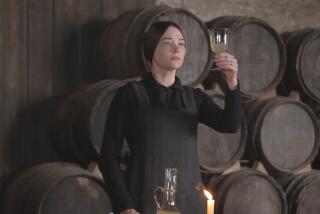Celebrating a Century of Gaumont : Movies: The revered French studio is the focus of a nine-week retrospective presenting historic, modern and rare films.
- Share via
When Nicolas Seydoux, the man who runs Gaumont, looks around for that entity’s peers, he doesn’t see any. “We are dean of all the movie companies in the world,” Seydoux says with not unnatural pride. “All the others have disappeared.”
For though Americans like to think that everything to do with motion pictures had its beginnings over here, it was in Paris in early 1895 that the Lumiere brothers had the first public showing of a projected film. And just a few months after that, a young man named Leon Gaumont took over a company that sold photographic and optical equipment and, not surprisingly, renamed it after himself.
Gaumont was primarily interested in things technical, but when the making of films helped the sale of his equipment, that was OK with him. Now, 100 years and some 7,000 films later, a cross section of the massive oak that grew from that tiny seed will be on display over nine weeks at UCLA’s Melnitz Hall in a remarkable series called “Gaumont Presents: A Century of French Cinema.”
From the earliest of silent films to the most modern international co-productions, Gaumont has been such an active player it’s considered the oldest continuously operating film studio in the world. Which is the reason for the program’s 13-city tour, touching down in Los Angeles today through Dec. 3. “When you are a century old, when you have a major birthday,” Seydoux explains, “of course you celebrate it.”
With its familiar daisy logo and its chain of cinemas, Gaumont is an established brand name in France. “From the beginning,” writes film historian Alan Williams, “they prided themselves on the technical quality of their films, but they have also been the most artistically oriented studio.”
So although the Gaumont name is not exactly celebrated here, many of its films are, and this series is a chance to see all of them fully restored, with new prints and even newly written English subtitles.
A case in point is Jean Vigo, the influential poet of personal cinema who died in 1934 at age 29. Gaumont is especially proud of its association with him, and in addition to his classics, “Zero de Conduite” and “L’Atalante,” two rarely screened shorts, “A propos de Nice” and “Taris et la natation” (Taris Swimming), will also be shown.
For audiences with still more modern tastes, the Gaumont series features everything from Eric Rohmer’s restrained “Die Marquise von O” (The Marquise of O) to the sentimental “Cousin, Cousine” and Luc Besson’s ultra-violent “La Femme Nikita.” Also, for those who didn’t get enough the last time around, the uncut, 192-minute version of Jean-Jacques Beineix’s “Betty Blue” will unspool.
*
For the true believers, however, the program’s most awaited treasures are its silent films, an unprecedented chance to see films by people such as Emile Cohl, Leonce Perret and the legendary Alice Guy (later Guy-Blache) who have mostly been no more than names in history books until now.
A master of a whole variety of visual techniques, Cohl is considered the pivotal figure in the history of animation, the first person to see it as a form apart from mere visual trickery, and his playful and charming shorts still amuse today.
On the same program Sunday with Cohl is Leonce Perret’s “Child of Paris,” which was considered the discovery of the festival when it played in Manhattan recently. Made in 1913, two years before D. W. Griffith’s “The Birth of a Nation,” it was called “the most important French film of its time” by archivist Henri Langlois. “Child,” the Dickensian story of a little girl without parents who gets repeatedly kidnaped and in general faces more perils than Pauline, is characterized by naturalistic acting and inventive visuals noticeably in advance of what anyone, even Griffith, was doing at the time.
As for Alice Guy, though she did receive some recognition late in life, her key position in film history was for a long time underreported. More than being the first female producer-director, she established the Gaumont house style of filming in real locations and is a contender for the title of first person ever to make a fiction film, 1896’s “The Cabbage Fairy.”
By the time she went to the United States in 1907, Guy had directed something like 300 films, including a complex “Life of Christ” and the charming “Sur la Barricade,” in which a man’s attempt to get some milk for his mother during the Paris Commune almost has dire results.
One of Guy’s proteges, Louis Feuillade, was responsible for some of the most memorable of all silent filmmaking, ambitious multi-hour serials such as “Judex” and “Les Vampires” that were a sensation when they first appeared and that continue to delight audiences.
“Les Vampires,” released in 1915-16, was banned for a time for being an “exaltation of evil” and is considered perhaps the first film to take that increasingly popular tack. Nominally the story of how a plucky reporter tracks down a criminal band that is intimidating all France, it is really more fascinated with the gang itself, a black-hooded and daring bunch that poisons, robs and terrorizes with impunity. And one of its leaders, the kohl-eyed Irma Vep (played by Musidora) was as bewitching as she was villainous.
*
Though these films’ French subtitles are fairly rudimentary, UCLA will provide a simultaneous verbal translation. Robert Israel will contribute organ accompaniment, and, as an extra inducement, the silents will be accompanied by Gaumont’s celebrated newsreels, offering glimpses of Monet painting among Giverny’s water lilies, a cigarette glued to his lips, and New York City motorcycle cops circa 1913 giving some of the world’s first speeding tickets.
On the same Oct. 27 bill with “La poison” is an exceptional work by a very different director, Robert Bresson’s austere 1956 classic “Un homme condamne a mort s’est echappe” (A Man Escaped). The film, acclaimed by Francois Truffaut as “the most important film of the last 10 years,” painstakingly delineates the imprisonment and plot to escape of a French resistance leader during World War II.
Based on a true story and told with Bresson’s trademark purity and control, this film is totally involving because of its avoidance of any kind of deliberately dramatic effect. Made with extensive use of close-ups, a sober voice-over, Mozart’s Mass in C minor and non-professional actors, “Escaped” is the best introduction to Bresson’s demanding but exhilarating style and probably his masterpiece as well. With both this and the Guitry showing in the best prints available in this country since their original release, this is the one Gaumont night to go to if you’re only going to one.
* UCLA’s Melnitz Theater is on the northeast corner of the Westwood campus, near the intersection of Sunset Boulevard and Hilgard Avenue. Tickets are $3 and $5 ; matinee tickets a re $3 and $1.50. Parking is available for $5. For information and schedule, call (310) 206-FILM.
More to Read
Only good movies
Get the Indie Focus newsletter, Mark Olsen's weekly guide to the world of cinema.
You may occasionally receive promotional content from the Los Angeles Times.








